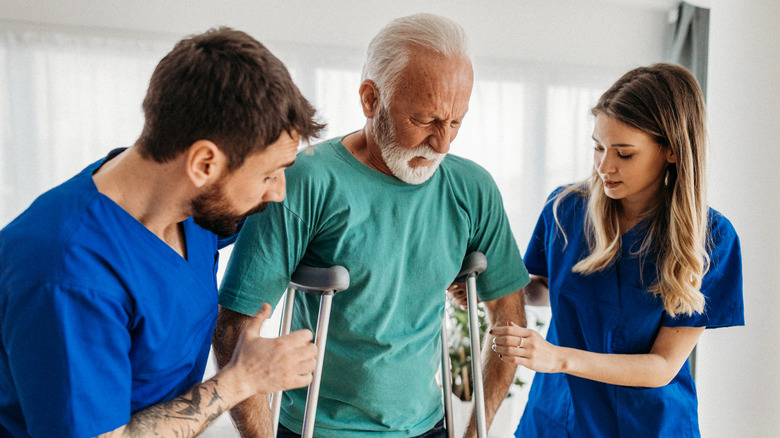This Injury Is Deadlier Than Cancer As You Age
Cancer is projected to be the cause of death for more than 611,000 Americans in the year 2024, reports the National Cancer Institute. Depending on what type of cancer a person is diagnosed with, survival rates can vary significantly. For example, the majority of cancer-related deaths stem from lung and bronchus cancer, but thyroid cancer, prostate cancer, and breast cancer, for example, have high rates of survival. Yet there's a common injury that affects many older adults that may increase the risk of mortality more than certain types of cancer, according to findings from a 2024 study published in JBMR Plus.
Annually, over 300,000 seniors end up in the hospital with a hip fracture, according to the U.S. Centers for Disease Control and Prevention (CDC). Usually the result of a fall, the risk of this potentially fatal injury increases as we age. The researchers from the study pulled health data pertaining to 98,474 bone fracture patients in Canada who were all at least 66 years of age. The majority of patients were women. With survival rates dropping most significantly within the month following many kinds of bone fractures, hip fractures proved to have the lowest survival rates over a five year period for adults ages 66 through 85.
Five-year survival rates tend to drop as patients with hip fractures age
The study revealed a 52% to 64% five-year survival rate for men between the ages of 66 and 85 who had sustained a hip fracture. Women of the same age were found to have a higher five-year survival rate of 70% to 79%, despite the fact that women tend to be more susceptible to bone fractures than men. These statistics dropped significantly with age, however, with survival rates following a hip fracture standing at 34.5% and 52.8% in men and women, respectively, who were at least 86 years of age.
The researchers note that the average five-year survival rate for any form of cancer is 64% for those ages 60 to 79, and 43% for those 80 or older. Although the age ranges don't match exactly between the two groups, these findings show that men ages 66 to 85 have a lower or equal five-year survival rate after a hip fracture (52% to 64%) than patients with cancer ages 60 to 79 do (64%). Again, hip fractures proved to be deadlier than cancer as patients grew older, at least for men. Compared to a 43% five-year survival rate for any type of cancer in people at least 80 years of age, men ages 86 or older with hip fractures were shown to have a 34.5% survival rate.
Tips for preventing hip fractures due to falls
A particularly wide gap was found between hip fractures and certain specific types of cancer in regards to five-year survival rates, according to the study findings. For comparison, males of any age had a 94% survival rate in cases of prostate cancer, while females had an 89% survival rate in cases of breast cancer. So what is it that makes hip fractures so dangerous for older adults? Most often tied to falls, a patient may be vulnerable to infection, blood clots in the lungs, pneumonia, and more following hip surgery, explains UCLA Health. Furthermore, broken bones take longer to heal as an adult, so if extended bed rest is required for recovery, muscle mass may continue to decrease, and the patient may be susceptible to additional falls.
To help reduce the risk of falling-related hip fractures, we want to make sure we're getting sufficient amounts of vitamin D and calcium to help support our bone health. Prioritizing physical activity, including balance exercises, can also help lower the odds of hip fractures. Additionally, alcohol can throw off our balance if consumed in excess, as well as decrease bone density, so consider limiting alcohol use. Finally, you'll want to keep up with regular eye exams to make sure your vision is in tip-top shape, and keep your home clear of any potential tripping hazards.


